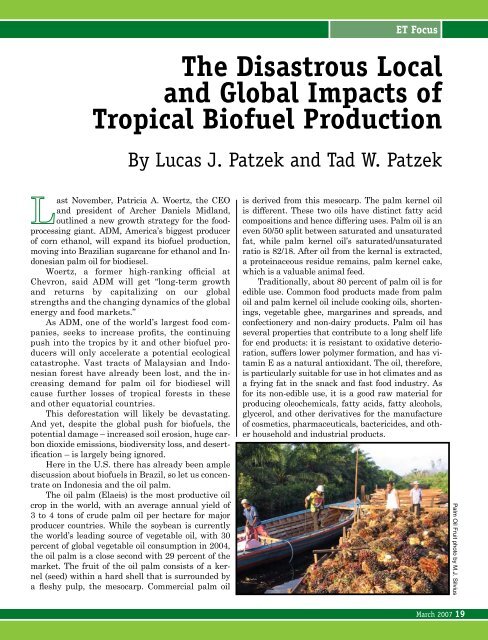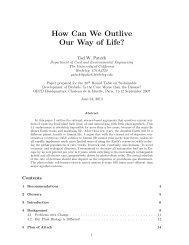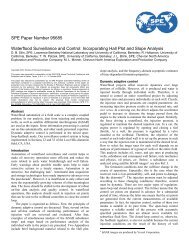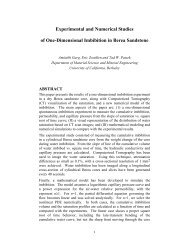ET Focus<strong>The</strong> <strong>Disastrous</strong> <strong>Local</strong><strong>and</strong> <strong>Global</strong> <strong>Impacts</strong> <strong>of</strong><strong>Tropical</strong> Bi<strong>of</strong>uel ProductionBy Lucas J. Patzek <strong>and</strong> Tad W. Patzekast November, Patricia A. Woertz, the CEO<strong>and</strong> president <strong>of</strong> Archer Daniels Midl<strong>and</strong>,outlined a new growth strategy for the foodprocessinggiant. ADM, America’s biggest producer<strong>of</strong> corn ethanol, will exp<strong>and</strong> its bi<strong>of</strong>uel production,moving into Brazilian sugarcane for ethanol <strong>and</strong> Indonesianpalm oil for biodiesel.Woertz, a former high-ranking <strong>of</strong>ficial atChevron, said ADM will get “long-term growth<strong>and</strong> returns by capitalizing on our globalstrengths <strong>and</strong> the changing dynamics <strong>of</strong> the globalenergy <strong>and</strong> food markets.”As ADM, one <strong>of</strong> the world’s largest food companies,seeks to increase pr<strong>of</strong>its, the continuingpush into the tropics by it <strong>and</strong> other bi<strong>of</strong>uel producerswill only accelerate a potential ecologicalcatastrophe. Vast tracts <strong>of</strong> Malaysian <strong>and</strong> Indonesianforest have already been lost, <strong>and</strong> the increasingdem<strong>and</strong> for palm oil for biodiesel willcause further losses <strong>of</strong> tropical forests in these<strong>and</strong> other equatorial countries.This deforestation will likely be devastating.And yet, despite the global push for bi<strong>of</strong>uels, thepotential damage – increased soil erosion, huge carbondioxide emissions, biodiversity loss, <strong>and</strong> desertification– is largely being ignored.Here in the U.S. there has already been amplediscussion about bi<strong>of</strong>uels in Brazil, so let us concentrateon Indonesia <strong>and</strong> the oil palm.<strong>The</strong> oil palm (Elaeis) is the most productive oilcrop in the world, with an average annual yield <strong>of</strong>3 to 4 tons <strong>of</strong> crude palm oil per hectare for majorproducer countries. While the soybean is currentlythe world’s leading source <strong>of</strong> vegetable oil, with 30percent <strong>of</strong> global vegetable oil consumption in 2004,the oil palm is a close second with 29 percent <strong>of</strong> themarket. <strong>The</strong> fruit <strong>of</strong> the oil palm consists <strong>of</strong> a kernel(seed) within a hard shell that is surrounded bya fleshy pulp, the mesocarp. Commercial palm oilis derived from this mesocarp. <strong>The</strong> palm kernel oilis different. <strong>The</strong>se two oils have distinct fatty acidcompositions <strong>and</strong> hence differing uses. Palm oil is aneven 50/50 split between saturated <strong>and</strong> unsaturatedfat, while palm kernel oil’s saturated/unsaturatedratio is 82/18. After oil from the kernal is extracted,a proteinaceous residue remains, palm kernel cake,which is a valuable animal feed.Traditionally, about 80 percent <strong>of</strong> palm oil is foredible use. Common food products made from palmoil <strong>and</strong> palm kernel oil include cooking oils, shortenings,vegetable ghee, margarines <strong>and</strong> spreads, <strong>and</strong>confectionery <strong>and</strong> non-dairy products. Palm oil hasseveral properties that contribute to a long shelf lifefor end products: it is resistant to oxidative deterioration,suffers lower polymer formation, <strong>and</strong> has vitaminE as a natural antioxidant. <strong>The</strong> oil, therefore,is particularly suitable for use in hot climates <strong>and</strong> asa frying fat in the snack <strong>and</strong> fast food industry. Asfor its non-edible use, it is a good raw material forproducing oleochemicals, fatty acids, fatty alcohols,glycerol, <strong>and</strong> other derivatives for the manufacture<strong>of</strong> cosmetics, pharmaceuticals, bactericides, <strong>and</strong> otherhousehold <strong>and</strong> industrial products.Palm Oil Fruit photo by M.J. SilviusMarch 2007 19
ET FocusBurning Peat Swamp photo by M.J. SilviusDem<strong>and</strong> in the 18th century persuaded Europeansto plant oil palm plantations. <strong>The</strong> first largeplantation was established in Indonesia around 1911,<strong>and</strong> can be traced back to four seedlings planted atBogor Botanical Garden. From these seedlings theDeli dura (thick-shelled) palms developed, with betterfruit composition <strong>and</strong> a larger proportion <strong>of</strong> mesocarpthan in African palms. Southeast Asia, <strong>and</strong> specificallyMalaysia, has dominated the industry eversince. Malaysia <strong>and</strong> Indonesia together currently accountfor 86 percent <strong>of</strong> global palm oil production <strong>and</strong>91 percent <strong>of</strong> its global exports. Malaysia produces42 percent <strong>and</strong> remains the leading exporter with 48percent <strong>of</strong> the world market. Indonesia produces 44percent <strong>of</strong> the world’s palm oil <strong>and</strong> is a close secondin exports, with 43 percent <strong>of</strong> the market.Indonesia is a far larger country than Malaysiawith a correspondingly larger work force, <strong>and</strong> the expectationis that Indonesia will eventually surpassMalaysia as an exporter. As long as there is political<strong>and</strong> economic stability, Indonesia will remain thelargest producer in the world.<strong>The</strong> present success <strong>of</strong> the oil palm industryin these two countries can be attributed to theirfavorable climatic conditions, well-established infrastructure,<strong>and</strong> an unsurpassed knowledge base,both in the oil’s actual production <strong>and</strong> in its upstream<strong>and</strong> downstream industries. Oil palm plantationsare being established at a rapid rate inseveral other Southeast Asian nations, includingThail<strong>and</strong>, the Philippines, <strong>and</strong> Papua New Guinea.However, by far the largest developments arefound in Indonesia. <strong>The</strong>se developments are chieflyfunded by Malaysians, although China, Europe,<strong>and</strong> the U.S. are also key players.<strong>The</strong> attention given to biodiesel by the U.S.<strong>and</strong> E.U. governments has spurred the dem<strong>and</strong> forpalm oil for biodiesel. <strong>The</strong> E.U. recently orderedthat 5.75 percent <strong>of</strong> all vehicle fuels come from renewablesources. <strong>The</strong> U.S. Internal Revenue Servicehas deemed oil palm as a feedstock for biodiesel,<strong>and</strong> therefore it is eligible for the biodiesel taxcredit <strong>of</strong> a penny per percent <strong>of</strong> biodiesel blendedwith petroleum diesel. <strong>The</strong>se moves by the world’sbiggest motor fuel markets have led to a surge <strong>of</strong>investment in Malaysian <strong>and</strong> Indonesian palm oilplantations. Indonesia’s largest plantation company,PT Astra Agro Lestari, has seen its shares jumpby about 80 percent over the past year.THE FIRES ARE HARD TO CONTROL ANDSPREAD EASILY TO ADJACENT FORESTS.In Indonesia, the oil palm plantations are owned<strong>and</strong> operated by many <strong>of</strong> the same companies that operatelogging, wood-processing, <strong>and</strong> pulp industries.(<strong>The</strong> Salim Group, the Raja Garuda Mas Group, <strong>and</strong>the Sinar Mas Group are all prime examples.) A naturalresult <strong>of</strong> this conjoining has been an increasein illegal <strong>and</strong> damaging l<strong>and</strong> use. A company with aplantation concession may only be interested in thel<strong>and</strong>’s timber. <strong>The</strong> trees will be cut down <strong>and</strong> hauledaway, no replanting effort will ensue, <strong>and</strong> the l<strong>and</strong>will be left deforested <strong>and</strong> degraded.Companies commonly set fires to clear l<strong>and</strong> forplantations. Besides being illegal in many countries,including Indonesia, the fires are hard tocontrol <strong>and</strong> spread easily to affect adjacent forests<strong>and</strong> communities. In 1997 <strong>and</strong> 1998 fires ragedthrough 6 percent <strong>of</strong> Indonesia, burning 11.7 millionhectares <strong>of</strong> l<strong>and</strong>. <strong>The</strong> majority <strong>of</strong> the fires occurredon plantation company l<strong>and</strong>, <strong>and</strong> threequarterswere oil palm plantations. <strong>The</strong> governmentaccused 176 companies <strong>of</strong> starting thesefires, <strong>of</strong> which 133 were oil palm plantation companies.Just 5 companies were actually taken tocourt <strong>and</strong> only one was penalized.<strong>The</strong> widespread tropical forest <strong>and</strong> peat firesin Indonesia during 1997, combined with the firesin Central <strong>and</strong> South America <strong>and</strong> in the borealregions <strong>of</strong> Eurasia <strong>and</strong> North America, emitted7.7 billion tons <strong>of</strong> carbon dioxide. <strong>The</strong> cumulativeemissions from these forest fires rival the world’stotal anthropogenic emissions. <strong>Tropical</strong> forest <strong>and</strong>peat burning in Indonesia has continued unabated.And these oil palm plantations can never sequesterback the carbon dioxide that is released inforest <strong>and</strong> peat burning.20 Energy Tribune









